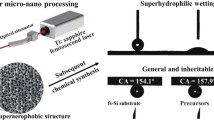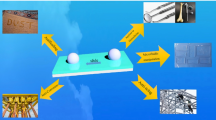Abstract
Fundamental research and practical applications have examined the manipulation of gas bubbles on open surfaces in low-surface-tension, high-pressure, and high-acidity, -alkalinity, or -salinity environments. However, to the best of our knowledge, efficient and general approaches to achieve the smart manipulation of gas bubbles in these harsh environments are limited. Herein, a Fluorinert-infused shape-gradient slippery surface (FSSS) that could effectively regulate the behavior of gas bubbles in harsh environments was successfully fabricated. The unique capability of FSSS was mainly attributed to the properties of Fluorinert, which include chemical inertness and incompressibility. The shape-gradient morphology of FSSS could induce asymmetric driving forces to move gas bubbles directionally on open surfaces. Factors influencing gas bubble transport on FSSS, such as the apex angle of the slippery surface and the surface tension of the aqueous environment, were carefully investigated, and large apex angles were found to result in large initial transport velocities and short transport distances. Lowering the surface tension of the aqueous environment is unfavorable to bubble transport. Nevertheless, FSSS could transport gas bubbles in aqueous environments with surface tensions as low as 28.5 ± 0.1 mN/m, which is lower than that of many organic solvents (e.g., formamide, ethylene glycol, and dimethylformamide). In addition, FSSS could also realize the facile manipulation of gas bubbles in various aqueous environments, e.g., high pressure (~ 6.8 atm), high acidity (1 mol/L H2SO4), high alkalinity (1 mol/L NaOH), and high salinity (1 mol/L NaCl). The current findings provide a source of knowledge and inspiration for studies on bubble-related interfacial phenomena and contribute to scientific and technological developments for controllable bubble manipulation in harsh environments.




Similar content being viewed by others
References
Sarkar MSK, Donne ASW, Evans GM (2010) Hydrogen bubble flotation of silica. Adv Powder Technol 21:412–418
Calgaroto S, Wilberg KQ, Rubio J (2014) On the nanobubbles interfacial properties and future applications in flotation. Miner Eng 60:33–40. https://doi.org/10.1016/j.mineng.2014.02.002
Patankar NA (2010) Supernucleating surfaces for nucleate boiling and dropwise condensation heat transfer. Soft Matter 6(8):1613–1620. https://doi.org/10.1039/b923967g
Zou JT, Zhang HG, Guo ZJ et al (2018) Surface nanobubbles nucleate liquid boiling. Langmuir 34(46):14096–14101. https://doi.org/10.1021/acs.langmuir.8b03290
Liu ZG, Gao XH, Du LX et al (2015) Corrosion behavior of low-alloy steel with martensite/ferrite microstructure at vapor-saturated CO2 and CO2-saturated brine conditions. Appl Surf Sci 351:610–623. https://doi.org/10.1016/j.apsusc.2015.06.006
López DA, Pérez T, Simison SN (2003) The influence of microstructure and chemical composition of carbon and low alloy steels in CO2 corrosion. A state-of-the-art appraisal. Mater Des 24(8):561–575. https://doi.org/10.1016/s0261-3069(03)00158-4
Liu Y, Cheng H, Lyu M et al (2014) Low overpotential in vacancy-rich ultrathin CoSe2 nanosheets for water oxidation. J Am Chem Soc 136:15670–15675
Bak T, Nowotny J, Rekas M et al (2002) Photo-electrochemical hydrogen generation from water using solar energy. Materials-related aspects. Int J Hydrog Energy 27(10):991–1022. https://doi.org/10.1016/s0360-3199(02)00022-8
Zhang CH, Cao MY, Ma HY et al (2017) Morphology-control strategy of the superhydrophobic poly(methyl methacrylate) surface for efficient bubble adhesion and wastewater remediation. Adv Funct Mater 27(43):1702020. https://doi.org/10.1002/adfm.201702020
Song JL, Liu ZA, Wang XY et al (2019) High-efficiency bubble transportation in an aqueous environment on a serial wedge-shaped wettability pattern. J Mater Chem A 7(22):13567–13576. https://doi.org/10.1039/c9ta02095k
Ju J, Zheng YM, Jiang L (2014) Bioinspired one-dimensional materials for directional liquid transport. Acc Chem Res 47(8):2342–2352. https://doi.org/10.1021/ar5000693
Cao MY, Jiang L (2016) Superwettability integration: concepts, design and applications. Surf Innov 4(4):180–194. https://doi.org/10.1680/jsuin.16.00004
Seymour RS, Hetz SK (2011) The diving bell and the spider: the physical gill of Argyroneta aquatica. J Exp Biol 214(13):2175–2181. https://doi.org/10.1242/jeb.056093
Kehl S, Dettner K (2009) Surviving submerged-setal tracheal gills for gas exchange in adult rheophilic diving beetles. J Morphol 270(11):1348–1355. https://doi.org/10.1002/jmor.10762
Flynn MR, Bush JWM (2008) Underwater breathing: the mechanics of plastron respiration. J Fluid Mech 608:275–296. https://doi.org/10.1017/s0022112008002048
Chen X, Wu YC, Su B et al (2012) Terminating marine methane bubbles by superhydrophobic sponges. Adv Mater 24(43):5884–5889. https://doi.org/10.1002/adma.201202061
Ma R, Wang JM, Yang ZJ et al (2015) Bioinspired gas bubble spontaneous and directional transportation effects in an aqueous medium. Adv Mater 27(14):2384–2389. https://doi.org/10.1002/adma.201405087
Yu CM, Cao MY, Dong ZC et al (2016) Spontaneous and directional transportation of gas bubbles on superhydrophobic cones. Adv Funct Mater 26(19):3236–3243. https://doi.org/10.1002/adfm.201505234
Duan JA, Dong XR, Yin K et al (2018) A hierarchical superaerophilic cone: robust spontaneous and directional transport of gas bubbles. Appl Phys Lett 113(20):203704. https://doi.org/10.1063/1.5054623
Yu CM, Cao MY, Dong ZC et al (2016) Aerophilic electrode with cone shape for continuous generation and efficient collection of H2 bubbles. Adv Funct Mater 26(37):6830–6835. https://doi.org/10.1002/adfm.201601960
Zheng QS, Yu Y, Zhao ZH (2005) Effects of hydraulic pressure on the stability and transition of wetting modes of superhydrophobic surfaces. Langmuir 21(26):12207–12212. https://doi.org/10.1021/la052054y
Cao MY, Li Z, Ma HY et al (2018) Is superhydrophobicity equal to underwater superaerophilicity: regulating the gas behavior on superaerophilic surface via hydrophilic defects. ACS Appl Mater Interfaces 10(24):20995–21000. https://doi.org/10.1021/acsami.8b05410
Tuteja A, Choi W, Mabry JM et al (2008) Robust omniphobic surfaces. Proc Natl Acad Sci U S A 105(47):18200–18205. https://doi.org/10.1073/pnas.0804872105
Yu C, Zhu C, Li K et al (2017) Manipulating bubbles in aqueous environment via a lubricant-infused slippery surface. Adv Funct Mater 27:1701605
Zhang CH, Zhang B, Ma HY et al (2018) Bioinspired pressure-tolerant asymmetric slippery surface for continuous self-transport of gas bubbles in aqueous environment. ACS Nano 12(2):2048–2055. https://doi.org/10.1021/acsnano.8b00192
Xiao X, Zhang C, Ma H et al (2019) Bioinspired slippery cone for controllable manipulation of gas bubbles in low-surface-tension environment. ACS Nano 13:4083–4090
Deng X, Mammen L, Butt HJ et al (2012) Candle soot as a template for a transparent robust superamphiphobic coating. Science 335(6064):67–70. https://doi.org/10.1126/science.1207115
Kovalchuk NM, Trybala A, Starov V et al (2014) Fluoro- vs hydrocarbon surfactants: why do they differ in wetting performance? Adv Colloid Interface Sci 210:65–71. https://doi.org/10.1016/j.cis.2014.04.003
Boutevin G, Tiffes D, Loubat C et al (2012) New fluorinated surfactants based on vinylidene fluoride telomers. J Fluorine Chem 134:77–84
Shi C, Cui X, Xie L et al (2015) Measuring forces and spatiotemporal evolution of thin water films between an air bubble and solid surfaces of different hydrophobicity. ACS Nano 9(1):95–104. https://doi.org/10.1021/nn506601j
Ducker WA (2009) Contact angle and stability of interfacial nanobubbles. Langmuir 25(16):8907–8910. https://doi.org/10.1021/la902011v
Ju J, Bai H, Zheng YM et al (2012) A multi-structural and multi-functional integrated fog collection system in cactus. Nat Commun 3:1247. https://doi.org/10.1038/ncomms2253
Prakash M, Quere D, Bush JWM (2008) Surface tension transport of prey by feeding shorebirds: the capillary ratchet. Science 320(5878):931–934. https://doi.org/10.1126/science.1156023
Zheng Y, Bai H, Huang Z et al (2010) Directional water collection on wetted spider silk. Nature 463:640–643
Li K, Ju J, Xue ZX et al (2013) Structured cone arrays for continuous and effective collection of micron-sized oil droplets from water. Nat Commun 4:2276. https://doi.org/10.1038/ncomms3276
Loudet JC (2004) Stokes drag on a sphere in a nematic liquid crystal. Science 306(5701):1525. https://doi.org/10.1126/science.1102864
Masliyah J, Jauhari R, Gray M (1994) Drag coefficients for air bubbles rising along an inclined surface. Chem Eng Sci 49(12):1905–1911. https://doi.org/10.1016/0009-2509(94)80075-8
Antonow GN (1907) Sur la tension superficielle des solutions dans la zone critique. J Chim Phys 5:364–371. https://doi.org/10.1051/jcp/1907050364
Antonoff G (1942) On the validity of Antonoff’s rule. J Phys Chem 46(4):497–499. https://doi.org/10.1021/j150418a009
Li YX, Li JX, Yang X et al (2019) Preparation of CeO2-modified Mg(Al)O-supported Pt–Cu alloy catalysts derived from hydrotalcite-like precursors and their catalytic behavior for direct dehydrogenation of propane. Trans Tianjin Univ 25(2):169–184. https://doi.org/10.1007/s12209-018-0156-4
Kong DC, Qi J, Liu DY et al (2019) Ni-doped BiVO4 with V4+ species and oxygen vacancies for efficient photoelectrochemical water splitting. Trans Tianjin Univ 25(4):340–347. https://doi.org/10.1007/s12209-019-00202-1
Li ZH, Zhang LJ, Zhao KC et al (2018) Ni/ZrO2 catalysts synthesized via urea combustion method for CO2 methanation. Trans Tianjin Univ 24(5):471–479. https://doi.org/10.1007/s12209-018-0126-x
Acknowledgements
This work was supported by the Beihang University’s Young Talents (No. KG16045301), the National Natural Science Foundation (No. 21805204), Tianjin Natural Science Foundation (No. 19JCQNJC05100), and Young Elite Scientists Sponsorship Program by Tianjin (No. TJSQNTJ-2018-17).
Author information
Authors and Affiliations
Corresponding authors
Electronic supplementary material
Below is the link to the electronic supplementary material.
Supplementary material 2 (MOV 4800 kb)
Supplementary material 3 (MOV 9153 kb)
Supplementary material 4 (MOV 2191 kb)
Supplementary material 5 (MOV 3152 kb)
Supplementary material 6 (MOV 2266 kb)
Supplementary material 7 (MOV 863 kb)
Rights and permissions
About this article
Cite this article
Liu, G., Zhang, C., Liu, M. et al. Smart Manipulation of Gas Bubbles in Harsh Environments Via a Fluorinert-Infused Shape-Gradient Slippery Surface. Trans. Tianjin Univ. 26, 441–449 (2020). https://doi.org/10.1007/s12209-020-00263-7
Received:
Revised:
Accepted:
Published:
Issue Date:
DOI: https://doi.org/10.1007/s12209-020-00263-7




